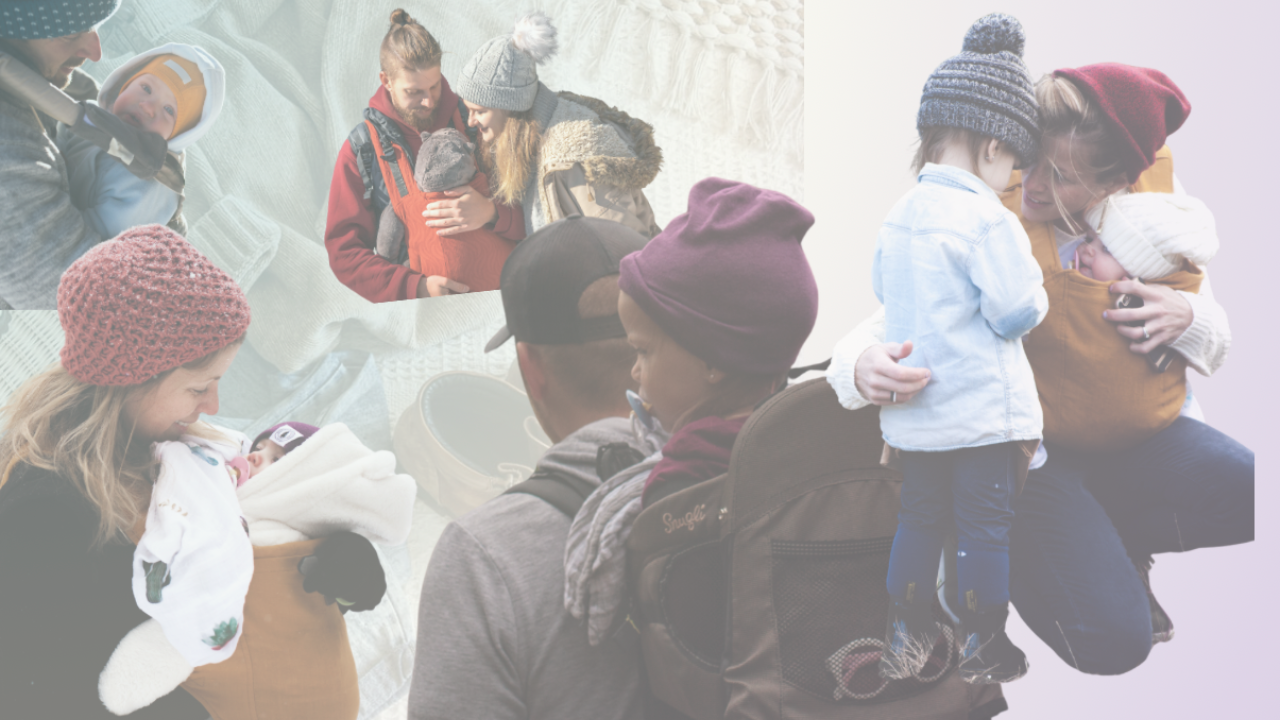What to Wear When Babywearing
Nov 18, 2025
• • •
Ask any experienced babywearer, and they’ll tell you: the right clothing can make or break a babywearing experience. It’s something that rarely gets talked about in babywearing tutorials, but as consultants, we know that comfort, fit, and ease of use all start with what’s worn underneath the carrier.
When you help families prepare for their babywearing journey, conversations about clothing can be just as important as conversations about carrier type or positioning. A few thoughtful tips can transform frustration into ease and turn a “this doesn’t feel right” moment into a confident, comfortable experience.
Layers don’t just insulate. They influence comfort, movement, and carrier performance.
Layers Matter
When the weather cools down, bulky sweaters and thick coats can make a carrier feel tight or awkward. Hoods get in the way, straps are suddenly too tight, and wraps just move your sweater and don’t tighten quite right. Light, flexible layers are usually the sweet spot, allowing caregivers to adjust as needed without compromising the fit.
Layers that move with you, not against you, work best. This can mean:
- A close-fitting base layer
- A zip-up fleece or light jacket that can go over both baby and caregiver (check out our blog here for why this matters)
- Avoid stiff seams or thick knits directly under straps and waistbands, as these can create pressure points over time.
Remind parents that they and their babies share body heat while babywearing. Too many layers can lead to overheating fast, especially for younger infants.
Sensory comfort is just as real as structural comfort.
Fabric Feel and Sensory Awareness
One person's jam is not another's. Some fabrics feel dreamy against the skin…others make you want to peel them off the minute you start moving. This is a critical factor for caregivers with sensory sensitivities or postpartum touch overload. In our experience, slippery/silky fabrics, as well as rough and scratchy textures, tend to contribute to the feeling of sensory overwhelm. However, like most things, this will vary from person to person, and as such, is a strong reason to visit a babywearing class or workshop before choosing a baby carrier or even registering for one.
Encourage caregivers to notice both their own reaction to the fabrics they’re wearing and how their fabrics interact. Synthetic material can be slippery and cause wraps to slide or bunch, and silky tops can make shoulder straps feel unstable. On the other hand, highly textured knits or embroidery can create friction that catches as you tighten a wrap or a sling.
For those who are prone to sensory overwhelm, soft, natural fibers often feel grounding. Cotton, bamboo, hemp, and wool blends can also regulate temperature well and absorb moisture, helping the wearer feel more comfortable, even during long carries. As an educator, having a variety of carriers and wraps available helps your clients experience the difference and encourages a person to choose their favorite.
Babywearing comfort often starts with the clothes no one thinks about.
Practical Clothing Choices
Babywearing isn’t just for short walks. Sometimes a 10-minute trip around the block turns into an hour-long nap in the carrier, and what you’re wearing can make a big difference in how you feel through it all.
Here are a few practical points to discuss with clients:
- Bathroom breaks: Suggest pants or skirts that are easy to adjust without needing to remove the carrier. Don’t forget to remind them to tuck or roll up excess fabric or webbing so it doesn’t accidentally fall into the toilet!
- Feeding access: For nursing or chestfeeding parents, stretchy necklines or nursing-friendly tops make it easier to feed in a carrier when needed.
- Footwear: Stable shoes are key, especially moving around with baby in arms. Slippery soles and unstable sandals can add unnecessary risk.
These details might seem small, but just a bit of forethought can make babywearing feel effortless in the moment.
Carriers + clothing = a relationship. Not a one-off setup.
When Clothing Meets Carrier Fabric
Carriers don’t exist in isolation; they interact with what we wear. A thick hoodie might make the H-clip and X-back straps feel uneven. A wrap might grab onto the hood and create an awkward lump. Even fabric finishes matter: a slightly rougher shirt can provide friction that helps keep a slippery carrier in place, while a smooth one might make it feel like it’s constantly shifting.
As consultants, it helps to normalize these trial-and-error moments. Encourage caregivers to do a quick “fit test” before heading out:
- How does the carrier feel over this outfit?
- Can they move comfortably, reach, bend, or sit?
- Does anything slip, bunch, or rub?
These questions not only empower caregivers to problem-solve, but they also reinforce the idea that babywearing is a living, adaptable skill, not something fixed in one perfect setup.
Comfort isn’t fancy. It’s foundational.
Comfort = Confidence
At its heart, helping families dress for babywearing is about supporting confidence and sustainability. When someone feels physically comfortable, they’re far more likely to keep wearing their baby.
Encourage clients to think of their clothing as part of their babywearing toolkit. Each layer, fiber, and fit choice contributes to how their carrier functions. And like any good toolkit, what works best might shift from day to day.
More Cold Weather Resources
• • •
Get Ahead of Cold and Wet Weather
Tips to help families prepare for the colder seasons and understand how weather changes affect comfort and fit.
Read more →How to Bundle for Cold and Wet Days
Layering advice and practical tips for keeping caregivers and babies safe, warm, and comfortable.
Read more →Why Carriers Help in Rain and Cold
How babywearing can make outings easier during unpredictable weather and reduce stress for families.
Read more →Babywearing Outerwear and When to Use It
Guidance on coats, covers, and layers that support safe and comfortable babywearing in cold climates.
Read more →

